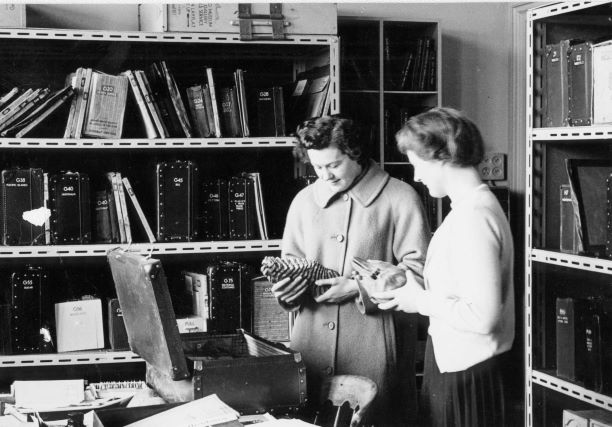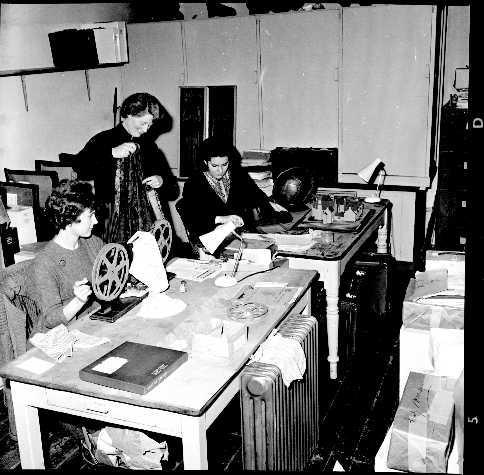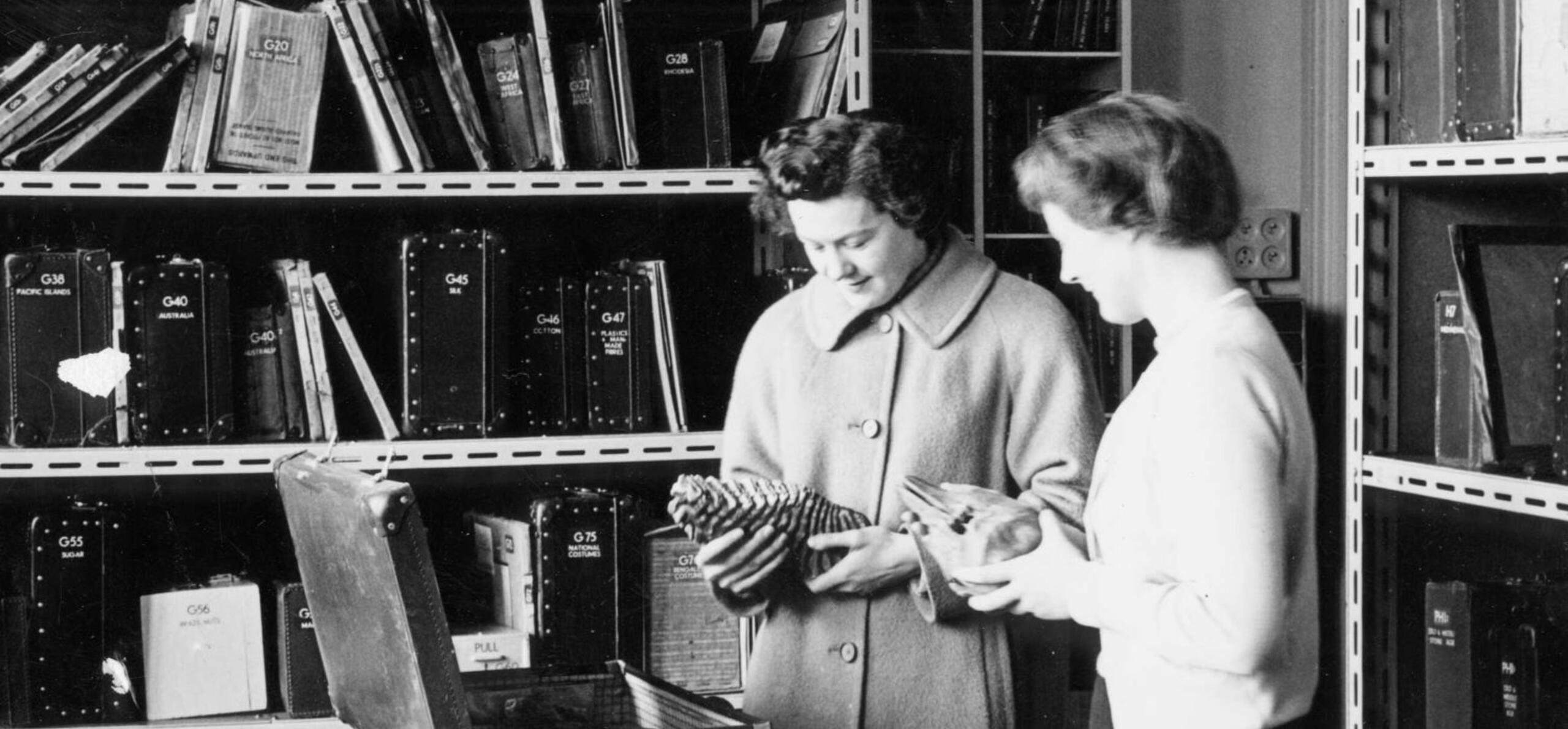Learn about the story of an iconic figure from Reading Museum's history: the brilliant Shirley Townend, who revolutionised the museum's schools service. Shirley died in 2019, and left behind an enormous legacy of bringing museum collections to generations of young people across our town. Written by Alexandra Jephson.
Shirley Townend (1922-2019) worked at the Reading Museum Loans Service as the Schools Liaison Officer for 36 years, from 1951 to 1987. The museum began loaning materials to schools in 1911, developing into a more formalised service in the 1920s. By 1930, the first cases containing specific collections had been lent to schools. In 1946, increasing demand for the collections led to the creation of the School Liaison Officer role, initially filled by Mr C.J. Scott and then Miss E.J. Dimelow. Shirley Townend was the third person to hold the position, joining the Reading Museum team in 1951.
Townend's early life
Townend grew up in Winchester, attending the Winchester County High School for Girls, where she gained a higher school certificate in botany. She went on to study botany and zoology at Southampton University College, graduating in 1944. Starting her career as a biologist, she worked as a laboratory technician at the University College of Wales, Aberystwyth, a role which had her 'brave the sea in winter to fish for water from different depths', alongside preparing materials for students.
Townend moved on to work at the Dale Fort field centre at Milford Haven, where an average of 50 students studying a range of subjects, including geology, history, zoology and botany were received. In 1951, she was given the opportunity to assist in a six-month survey on the island bird observatory of Skokholm. In this role, she acted as cook to ten students, the warden and his assistant, and aided the warden with his research into the development of wheatears.

A teacher chooses a loan box with Shirley Townend (on the right), the museum's School Liaison Officer, about 1956. (Object number 2001.80.4)
Arriving in Reading and the beginning of the Loans Service
After the survey was completed, Townend decided to switch her career path, moving to Reading, where she was offered the Liaison Officer position at Reading Museum. As someone 'interested in practical work and education, but wanting to avoid teaching', she found this was a role in which she could combine both.
At first sight it looks like a left luggage office. Case big and small are cramped together on numerous shelves. Inside are beetles, earwigs and wasps…skeletons, anatomies and dissections…snakes, lizards and frogs’ legs.
- 'Three young women take exhibits to the schools', Reading Standard, September 1, 1961
In the early 1960s, the loans office was run by Townend and two other women: 28-year-old ex-schoolteacher Pat Stinton, who 'took a pay cut in favour of more practical work', and 17-year-old Pam Ballard, a 'former window dresser'. Between them, they were responsible for maintaining and repairing some 800 school loan box collections, preparing them for send-out, and cataloguing all the specimens they received. In an interview in 1961, Townend said their main qualifications were: 'an interest in practical work, some knowledge of various subjects, and strong stomachs'.
In 1960 alone, 5,243 collections were loaned out to schools in Reading, Berkshire and South Oxfordshire. This figure grew to almost 15,000 by 1971, a year in which over 3,000 requests had to be denied due to exhibits being in short supply.
As the service’s popularity increased, the loans office grew to accommodate the greater demands, moving to Yeomanry House in 1970-71. In 1972, alongside Townend, the office included: former woodturner Ray Lewington, who built miniature working models, including old looms, water pumps and guillotines, for children to look at and use; historian Elizabeth Utting; arts and crafts expert Godfrey Omer Parsons; three junior helpers; and clerical staff.
Making one hedgehog do for 400 schools and replacing the wrapping on a mummified cat. These are the sort of tricky little problems that Miss Shirley Townend faces daily.
- The Curious Demands on a Curiosity Shop, David Snelling in the Reading Evening Post, October 28, 1972
The collections consisted of spare museum material, purchased materials and public donations, alongside what they themselves made or collected. Townend used to gather materials by getting her contacts in Commonwealth countries to send materials, and collected her own on her trips, including bringing back a reindeer skin from a trip to Canada in the early 1970s. In an interview in 1972, she 'confessed to having a "grasshopper mind”' and was 'constantly fascinated' by each new piece that came in. She also had plans to introduce a proper teaching service once the museum was built next to the Butts Centre, with 'museum staff giving talks, field tours and school visits to the museum'.

Shirley Townend (standing) with museum loan boxes in 1963 (museum number REDMG : 1980.36.D784.2)
This new museum never happened, but the loans service continued to grow until 1976-77, where nearly 20,000 collections were loaned to schools. However, this created too great a workload, resulting in the service being cut back. Items per school were lowered from twelve to three and the staff were cut down from eleven to four.
For a woman who welcomes change, who knows what possibilities lie ahead?
- 'A biologist’s life can be full of adventure', Jeanette Martin, Reading Standard, Friday 16 August 1957
Shirley's life in our town
Outside of Reading Museum, Townend continued to pursue her interests in nature and biology, joining the Reading and District Natural History Society (RDNHS) upon her arrival in Reading in 1951. She acted as a committee member from 1960-1985 and was President from 1975-1977. She was also a talented nature artist, illustrating for the Collins Pocket Guide to the Seashore, first published in 1958. Her original watercolours are held in the Reading Museum collections today (object no. 2004.94.1=32).
While Townend left the museum in 1987, she maintained her connections, returning to hold events such as 'Lunchtime Explorations'. One of these, on 2 August 1994, explored the themes of frogs in literature.
She became a volunteer for the West Street/Oxford Road Save the Children charity shop, which received a prize in 1999 for the best shop window, as part of a competition organised by the Reading Volunteer Bureau for National Volunteer Week. She and her colleague Phyll Brailli were presented the award by MP Jane Griffiths and Mayor Steve Waite.
To find out more about the Reading Museum schools service today, and how we share our collections and history with children both in the museum and online, visit our schools pages.
References
- A Window on Unsung Heroes. Reading Evening Post, Friday 11 June 1999. Accessed via the British Newspaper Archive (www.britishnewspaperarchive.co.uk), Image © Reach PLC and created courtesy of the British Library Board
- David Snelling: The curious demands on a curiosity shop. Reading Evening Post, Saturday 28 October 1972. Accessed via the British Newspaper Archive (www.britishnewspaperarchive.co.uk), Image © Reach PLC and created courtesy of the British Library Board
- Jeanette Martin: A Biologist’s Life Can Be Full of Adventure. Reading Standard, Friday 16 August 1957. Accessed via the British Newspaper Archive (www.britishnewspaperarchive.co.uk), Image © Reach PLC and created courtesy of the British Library Board
- Lunchtime Explorations with Shirley Townend. Reading Evening Post, Monday 1 August 1999. Accessed via the British Newspaper Archive (www.britishnewspaperarchive.co.uk), Image © Reach PLC and created courtesy of the British Library Board
- Reading Naturalist No.72: Report for 2019. Available at: http://rdnhs.org.uk/blog/wp-content/uploads/ReadingNaturalistNo.-72-201…
- Reading Museum (2020): #LoveCulture Week: Reading’s Women Collectors. Available at: https://www.readingmuseum.org.uk/blog/loveculture-week-readings-women-c…
- Still Working to Save the Children. Reading Evening Post, Friday 20 May 1994. Accessed via the British Newspaper Archive (www.britishnewspaperarchive.co.uk), Image © Reach PLC and created courtesy of the British Library Board
- Three Young Women Take Exhibits to the Schools. Reading Standard, Friday 1 September 1961. Accessed via the British Newspaper Archive (www.britishnewspaperarchive.co.uk), Image © Reach PLC and created courtesy of the British Library Board





